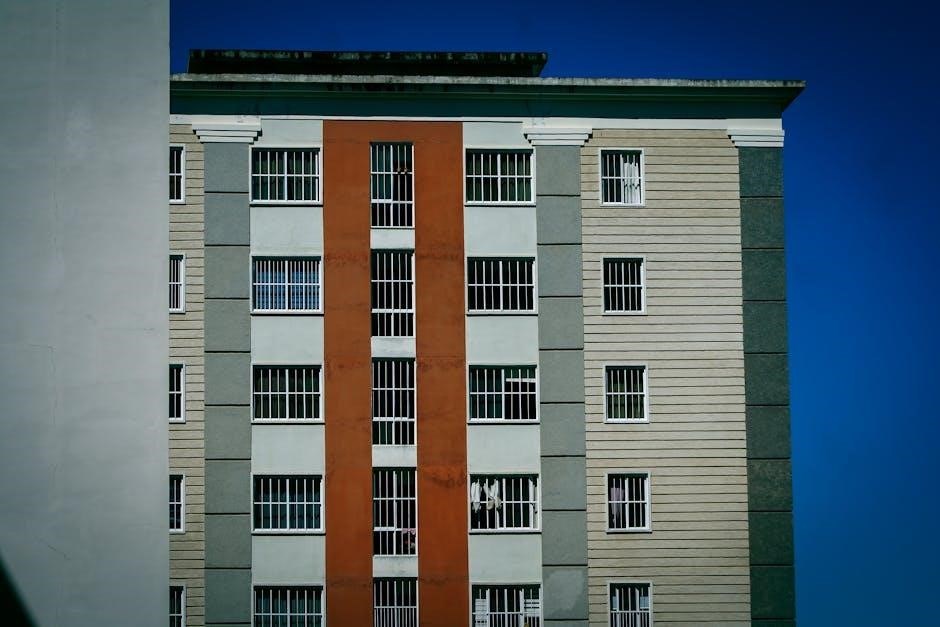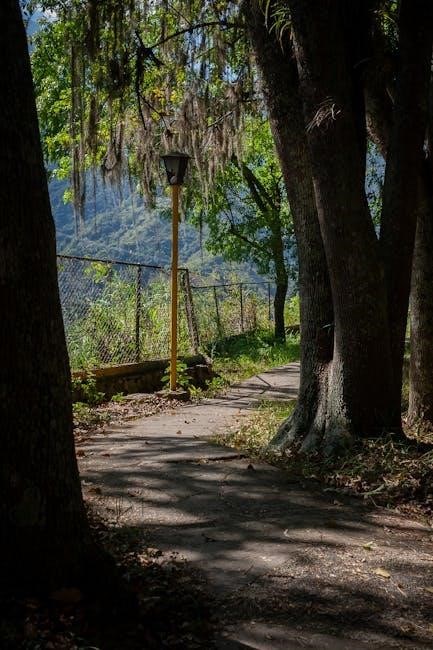Venezuela’s protected areas are vital for preserving its rich biodiversity and natural heritage‚ covering over 46% of the national territory and supporting sustainable development through conservation efforts.
1.1 Overview of the Importance of Protected Areas
Protected areas in Venezuela play a critical role in safeguarding the nation’s biodiversity‚ ecological balance‚ and natural heritage. These regions‚ including national parks‚ wildlife refuges‚ and natural monuments‚ cover nearly 46% of Venezuela’s territory. They are essential for preserving unique ecosystems‚ such as mangrove forests and dry ecosystems‚ which serve as habitats for diverse species. Additionally‚ these areas protect vital water resources‚ ensuring the sustainability of hydroelectric power and ecosystems. The publication Áreas Protegidas de Venezuela Tomo I highlights the significance of these regions‚ emphasizing their role in sustainable development and environmental education. Protecting these areas is crucial for maintaining ecological services and supporting economic activities like ecotourism.
1.2 Brief History of Conservation Efforts in Venezuela
Venezuela’s conservation efforts began gaining momentum in the mid-20th century‚ with the establishment of its first national parks in the 1940s. The creation of Parque Nacional Médanos de Coro in 1987 marked a significant step in protecting unique ecosystems. Over the years‚ the country expanded its network of protected areas‚ including wildlife refuges‚ natural monuments‚ and biosphere reserves. The publication of Áreas Protegidas de Venezuela Tomo I in 2009 underscored the importance of these efforts‚ documenting 10 key national parks. This initiative reflected Venezuela’s commitment to preserving its natural heritage and addressing global conservation challenges through legal frameworks and international collaborations.

Classification of Protected Areas in Venezuela
Venezuela’s protected areas are categorized into national parks‚ natural monuments‚ wildlife refuges‚ and biosphere reserves‚ each serving distinct roles in preserving the nation’s diverse ecosystems and biodiversity.
2.1 National Parks
Venezuela boasts 43 national parks‚ each showcasing unique ecosystems and biodiversity. These parks are integral to preserving the country’s natural heritage‚ covering diverse landscapes from tropical rainforests to coastal dunes.
They protect critical habitats for endemic species and offer opportunities for eco-tourism‚ promoting sustainable development. National parks are legally designated to safeguard Venezuela’s environmental and cultural treasures for future generations.
2.2 Natural Monuments
Natural monuments in Venezuela are designated to protect specific natural features of exceptional beauty or scientific significance. There are 36 such areas‚ each focusing on preserving unique geological formations‚ landscapes‚ or rare ecosystems. These monuments often highlight Venezuela’s natural diversity‚ from stunning rock formations to pristine coastal areas. They play a crucial role in maintaining biodiversity and serve as important sites for scientific research and eco-tourism. Legal protections ensure these natural wonders are safeguarded for future generations‚ contributing to the country’s environmental and cultural heritage. Natural monuments complement national parks‚ offering a balanced approach to conservation and sustainable development in Venezuela.
2.3 Wildlife Refuges and Reserves
Venezuela’s wildlife refuges and reserves are critical for safeguarding vulnerable species and their habitats. These protected areas focus on conservation efforts for endangered flora and fauna‚ ensuring their survival in unique ecosystems. With 7 wildlife refuges and 7 reserves‚ they cover diverse habitats‚ from wetlands to tropical forests‚ providing sanctuary for native species. These areas are essential for biodiversity‚ supporting species recovery programs and maintaining ecological balance. Legal protections ensure these refuges and reserves remain intact‚ offering a safe haven for wildlife and contributing to Venezuela’s broader conservation goals. They play a vital role in preserving the country’s natural heritage for future generations.
2.4 Biosphere Reserves
Venezuela boasts two UNESCO-recognized biosphere reserves‚ which are integral to its conservation strategy. These reserves promote sustainability by balancing human activities with biodiversity preservation. They encompass diverse ecosystems‚ such as tropical rainforests and unique geological formations‚ supporting a wide variety of flora and fauna. Biosphere reserves play a crucial role in maintaining ecological balance and fostering scientific research. Legal protections ensure these areas remain pristine‚ safeguarding their natural and cultural heritage. They exemplify Venezuela’s commitment to global environmental agreements‚ emphasizing the importance of harmonizing human development with nature. These reserves are vital for long-term ecological health and sustainable practices in the region.

Key Features of the Publication “Áreas Protegidas de Venezuela Tomo I”
This publication‚ registered with ISBN 978-980-04-1461-3‚ details Venezuela’s protected areas‚ including 43 national parks‚ 36 natural monuments‚ and biosphere reserves‚ showcasing their ecological and cultural significance.
3.1 ISBN and Publication Details
The publication “Áreas Protegidas de Venezuela Tomo I” is officially registered with the ISBN 978-980-04-1461-3 by the Venezuelan ISBN Agency. Published in 2009 by the Ministry of Popular Power for the Environment in Caracas‚ the book is part of a series documenting Venezuela’s protected areas. It features detailed information on national parks‚ natural monuments‚ wildlife refuges‚ and biosphere reserves. The document is available under a Creative Commons License‚ ensuring accessibility for educational and non-commercial purposes. This publication serves as a valuable resource for understanding Venezuela’s conservation efforts and the significance of its protected territories.
3.2 Authors and Contributors
The publication “Áreas Protegidas de Venezuela Tomo I” was authored by renowned experts in environmental science and conservation. Leonel Vivas and Jesús Alexander Cegarra Rodríguez are prominent contributors‚ bringing extensive knowledge of Venezuela’s ecosystems. María Teresa Rondón Sulbarán also participated‚ adding valuable insights. The Ministry of Popular Power for the Environment oversaw the project‚ ensuring scientific accuracy and relevance. Contributors included researchers‚ ecologists‚ and conservationists dedicated to documenting Venezuela’s biodiversity. Their collaborative effort highlights the importance of teamwork in preserving natural heritage. The publication is a testament to their commitment to environmental stewardship and education‚ making it a key resource for conservation efforts in Venezuela.

3.4 Scope and Objectives of the Publication
The publication “Áreas Protegidas de Venezuela Tomo I” aims to document and promote the country’s protected areas‚ emphasizing their ecological significance and conservation status. Its scope includes detailed descriptions of national parks‚ wildlife refuges‚ and natural monuments‚ highlighting their biodiversity and unique ecosystems. A key objective is to raise public awareness about the importance of these areas for sustainable development and environmental preservation. The book also serves as an educational tool‚ providing insights into the challenges faced by these regions and the efforts to protect them. By fostering understanding and appreciation‚ it encourages community involvement in conservation initiatives‚ ensuring the preservation of Venezuela’s natural heritage for future generations.

Biodiversity and Ecological Significance
Venezuela’s protected areas harbor remarkable biodiversity‚ featuring unique ecosystems such as rainforests and coastal regions‚ which are crucial for maintaining ecological balance and supporting diverse wildlife populations.
4.1 Unique Ecosystems in Venezuela
Venezuela boasts an extraordinary array of unique ecosystems‚ ranging from the lush rainforests of the Amazon and Orinoco basins to the arid dunes of Médanos de Coro. The Guiana Shield‚ one of the oldest geological formations on Earth‚ harbors pristine tepuis and endemic species. Coastal regions feature mangrove forests and coral reefs‚ such as those in Los Roques‚ teeming with marine life. The Andean highlands provide alpine habitats‚ while the llanos offer vast grasslands dotted with moriche palms. These ecosystems‚ documented in “Áreas Protegidas de Venezuela Tomo I‚” are not only biodiverse but also critical for climate regulation and water supply‚ making them invaluable natural assets.
4.2 Endangered Species and Their Habitats
Venezuela is home to numerous endangered species‚ including jaguars‚ giant otters‚ and harpy eagles‚ which rely on the country’s diverse ecosystems for survival. These species inhabit unique habitats such as the dense rainforests of the Amazonas state‚ the wetlands of the Orinoco Delta‚ and the mountainous regions of the Andes. The giant otter thrives in freshwater rivers and lakes‚ while the jaguar roams across various landscapes‚ from grasslands to cloud forests. Protected areas play a crucial role in safeguarding these species by preserving their habitats and reducing threats like deforestation and hunting; Efforts documented in “Áreas Protegidas de Venezuela Tomo I” highlight the importance of conservation to ensure the survival of these iconic creatures.
4.3 Role of Protected Areas in Maintaining Biodiversity
Protected areas in Venezuela are essential for maintaining biodiversity by safeguarding unique ecosystems and providing habitats for diverse flora and fauna. These areas protect key species and genetic resources‚ ensuring ecological balance. They also mitigate climate change by preserving carbon sinks in forests and wetlands. The “Áreas Protegidas de Venezuela Tomo I” emphasizes how these regions support ecological services vital for human well-being‚ such as clean water and soil conservation. By maintaining these areas‚ Venezuela upholds its commitment to global biodiversity conservation‚ ensuring a sustainable future for both its natural heritage and local communities dependent on these ecosystems for their livelihoods and cultural practices.
Conservation Efforts and Management
Venezuela’s protected areas are managed through strategic conservation initiatives‚ addressing habitat loss‚ climate change‚ and human impact to preserve biodiversity and ecological balance for future generations.
5.1 Challenges in Protecting Venezuelan Ecosystems
Protecting Venezuelan ecosystems faces significant challenges‚ including habitat loss due to illegal mining‚ logging‚ and agricultural expansion. Climate change exacerbates these issues‚ altering ecosystems and threatening biodiversity. Additionally‚ socio-political instability has led to reduced funding and institutional capacity for conservation efforts. Infrastructure projects‚ such as power lines and roads‚ often encroach on protected areas‚ further fragmenting habitats. Despite legal frameworks‚ enforcement remains weak‚ allowing illegal activities to persist. These challenges underscore the need for strengthened governance‚ international support‚ and community engagement to safeguard Venezuela’s natural heritage and maintain ecological balance for future generations.
5.2 Community Involvement in Conservation

Community involvement plays a crucial role in conservation efforts in Venezuela‚ fostering a sense of ownership and responsibility among local populations. Educational programs and workshops highlight the importance of protected areas‚ encouraging sustainable practices. Local communities participate in ecological restoration projects‚ such as reforestation and clean-up initiatives‚ contributing to the preservation of biodiversity. Additionally‚ communities collaborate with authorities in monitoring illegal activities‚ ensuring the enforcement of conservation laws. This active engagement not only strengthens conservation outcomes but also promotes socio-economic benefits‚ aligning environmental protection with community well-being. Such participatory approaches are essential for the long-term sustainability of Venezuela’s protected areas and natural resources.
5.3 International Collaboration and Support
International collaboration and support are instrumental in strengthening conservation efforts in Venezuela. Partnerships with global organizations‚ such as the United Nations Environment Programme (UNEP) and the International Union for Conservation of Nature (IUCN)‚ provide critical resources and expertise. These collaborations facilitate access to funding‚ advanced technologies‚ and knowledge-sharing platforms‚ enabling more effective management of protected areas. Additionally‚ international agreements‚ like the Inter-American Convention‚ underscore Venezuela’s commitment to global conservation goals. Such support not only enhances the capacity of local institutions but also elevates the visibility of Venezuela’s biodiversity‚ fostering a collective responsibility to safeguard its unique ecosystems for future generations.

Notable Protected Areas in Venezuela
Venezuela boasts iconic protected areas like Parque Nacional Canaima and Monumento Natural Los Roques‚ showcasing its diverse ecosystems and biodiversity‚ which are vital for ecological balance and tourism.
6.1 Parque Nacional Médanos de Coro
Parque Nacional Médanos de Coro‚ located in the central coast of Falcón State‚ is a unique protected area known for its stunning sand dunes stretching alongside the Caribbean Sea; This park is not only a natural wonder but also a significant ecological site‚ providing habitat for diverse flora and fauna adapted to its arid conditions. It attracts tourists and researchers alike‚ offering insights into Venezuela’s geological and biological diversity. The park’s protected status ensures the preservation of this fragile ecosystem‚ making it a vital component of Venezuela’s environmental heritage.

6.2 Parque Nacional Canaima
Parque Nacional Canaima‚ located in southeastern Venezuela‚ is renowned for its breathtaking landscapes and unique geological formations. It is home to the iconic Angel Falls‚ the highest uninterrupted waterfall in the world‚ and features expansive tepuis‚ or tabletop mountains. The park is a UNESCO World Heritage site‚ recognizing its exceptional natural beauty and biodiversity. Canaima boasts lush rainforests‚ diverse wildlife‚ and vibrant indigenous communities‚ making it a cornerstone of Venezuela’s ecological heritage. Its protected status ensures the preservation of these natural wonders and supports sustainable tourism‚ fostering environmental education and conservation efforts in the region.
6.3 Monumento Natural Los Roques
Monumento Natural Los Roques is a stunning archipelago located off Venezuela’s northern coast‚ comprising 50 islands and numerous cays. Known for its pristine coral reefs and crystal-clear waters‚ it is a vital marine ecosystem. The area is home to diverse marine life‚ including sea turtles‚ dolphins‚ and over 200 species of fish. Los Roques is a protected region‚ emphasizing its ecological importance and the need for sustainable conservation practices. Its unique biodiversity and breathtaking beauty make it a key destination for ecotourism and scientific research‚ contributing to Venezuela’s environmental heritage and global biodiversity preservation efforts.
Legal Framework and Policy
Venezuela’s protected areas are governed by specific laws and international agreements‚ ensuring the conservation of its biodiversity and natural resources through legal and policy frameworks.
7.1 Laws Governing Protected Areas in Venezuela
The legal framework protecting Venezuela’s natural heritage includes specific laws like the Ley de Protección y Uso Sostenible del Patrimonio Natural‚ which regulates national parks‚ natural monuments‚ and wildlife reserves. These laws aim to conserve biodiversity‚ ensure sustainable use of resources‚ and protect unique ecosystems. The Organic Environmental Law and the Forest Law also play crucial roles in enforcing conservation practices and penalizing environmental violations. Additionally‚ international agreements ratified by Venezuela further strengthen these legal protections‚ ensuring compliance with global conservation standards. These laws are essential for maintaining the ecological balance and preserving the country’s natural treasures for future generations.
7.2 International Agreements and Conventions
Venezuela is a signatory to several international agreements that bolster the protection of its protected areas. These include the Convention on Biological Diversity‚ the Ramsar Convention for wetland conservation‚ and the UNESCO World Heritage Convention. These agreements provide a global framework for safeguarding biodiversity and natural heritage. Venezuela’s participation in these conventions underscores its commitment to international environmental governance and the sustainable management of its ecosystems. These agreements also facilitate collaboration with global organizations‚ ensuring that Venezuela’s protected areas align with worldwide conservation standards and practices‚ thereby enhancing their effectiveness in preserving the nation’s natural resources for future generations.
The Role of Protected Areas in Sustainable Development
Protected areas in Venezuela play a crucial role in sustainable development by supporting ecotourism‚ preserving natural resources‚ and promoting environmental education‚ thereby fostering economic and social well-being.
8.1 Ecotourism and Economic Benefits
Ecotourism in Venezuela’s protected areas offers significant economic benefits by attracting visitors to unique ecosystems like Canaima National Park and Los Roques Natural Monument. These destinations‚ highlighted in Áreas Protegidas de Venezuela Tomo I‚ showcase breathtaking landscapes‚ fostering sustainable tourism. By supporting local communities through job creation in hospitality‚ guiding‚ and handicrafts‚ ecotourism contributes to regional development. Additionally‚ revenue generated from ecotourism helps fund conservation initiatives and infrastructure‚ ensuring the preservation of these natural wonders for future generations while promoting environmental stewardship and cultural exchange.
8.2 Environmental Education and Awareness
Environmental education plays a crucial role in promoting the importance of Venezuela’s protected areas. Through initiatives like workshops‚ guided tours‚ and educational materials‚ communities gain insights into conservation. The publication Áreas Protegidas de Venezuela Tomo I serves as a valuable resource‚ highlighting the ecological significance of these regions; By fostering awareness‚ these efforts encourage active participation in protecting biodiversity and natural heritage‚ ensuring that future generations understand the importance of conservation and sustainable practices in maintaining Venezuela’s unique ecosystems and natural beauty.

Challenges and Threats to Protected Areas
Venezuela’s protected areas face threats like deforestation‚ climate change‚ and illegal activities‚ while socio-political instability and insufficient funding exacerbate conservation challenges‚ endangering biodiversity and ecosystems.
9.1 Environmental Threats
Deforestation‚ illegal mining‚ and logging pose significant threats to Venezuela’s protected areas‚ leading to habitat loss and biodiversity decline. Climate change exacerbates these issues‚ causing erratic weather patterns and rising temperatures that disrupt delicate ecosystems. Additionally‚ pollution from agricultural runoff and industrial activities further degrades natural habitats. These environmental threats undermine the effectiveness of protected areas‚ threatening the survival of unique species and ecosystems‚ such as mangrove forests and dry forests‚ which are critical for maintaining ecological balance. Without urgent action‚ these threats could irreparably damage Venezuela’s natural heritage‚ highlighting the need for robust conservation measures to safeguard these vital ecosystems.
9.2 Socio-Political Challenges
Venezuela’s protected areas face significant socio-political challenges‚ including political instability‚ weak governance‚ and insufficient funding for conservation efforts. Economic crises have led to reduced investment in environmental protection‚ exacerbating habitat degradation. Additionally‚ land-use conflicts arise from illegal activities such as mining and logging‚ often driven by informal economies. Local communities sometimes view protected areas as barriers to development‚ leading to tensions between conservation goals and livelihood needs. These challenges are compounded by limited public awareness and participation in conservation efforts‚ highlighting the need for stronger institutional frameworks and community engagement to ensure the long-term sustainability of Venezuela’s protected areas.
The Future of Protected Areas in Venezuela

The future of Venezuela’s protected areas lies in strategic conservation plans‚ advanced technology‚ and stronger international collaboration to safeguard biodiversity and promote sustainable development.
10.1 Strategic Plans for Conservation
Strategic plans for conservation in Venezuela’s protected areas aim to integrate local communities‚ protect critical ecosystems‚ and ensure sustainable development. These plans emphasize biodiversity preservation‚ ecological balance‚ and addressing threats like deforestation and climate change. By fostering collaboration between stakeholders‚ the initiatives seek to enhance resource management and promote eco-friendly practices. The goal is to create a framework that aligns conservation efforts with societal needs‚ ensuring the long-term viability of Venezuela’s natural heritage.
10.2 The Role of Technology in Modern Conservation
Technology plays a pivotal role in modern conservation efforts within Venezuela’s protected areas. Advanced tools like satellite monitoring‚ GPS tracking‚ and data analytics enable precise ecosystem management and biodiversity tracking. Drones are utilized for patrolling vast regions‚ detecting illegal activities‚ and assessing environmental changes. Digital platforms facilitate community engagement and education‚ fostering a collective responsibility for conservation. Additionally‚ technology aids in creating detailed maps of protected zones‚ helping to identify priority areas for preservation. By integrating these innovations‚ Venezuela can enhance the efficiency and sustainability of its conservation strategies‚ ensuring the long-term protection of its natural heritage.
Venezuela’s protected areas are essential for biodiversity conservation‚ ensuring ecological balance and sustainable development. “Áreas Protegidas de Venezuela Tomo I” highlights their significance‚ guiding future preservation efforts effectively.
11.1 Summary of Key Points
The publication “Áreas Protegidas de Venezuela Tomo I” emphasizes the importance of protected areas in preserving biodiversity and ecological balance. It highlights Venezuela’s extensive network of national parks‚ natural monuments‚ wildlife refuges‚ and biosphere reserves‚ covering over 46% of the country. The book‚ registered with ISBN 978-980-04-1461-3‚ was published by the Ministry of Popular Power for the Environment in 2009. It underscores the challenges faced by these areas‚ including environmental threats and socio-political issues‚ while advocating for sustainable development through ecotourism and community involvement. The publication serves as a vital resource for understanding the significance of conservation efforts in Venezuela.
11.2 Final Thoughts on the Importance of Conservation
Conservation of Venezuela’s protected areas is crucial for safeguarding biodiversity‚ ensuring ecological balance‚ and supporting sustainable development. These areas‚ covering nearly half of the country‚ protect vital ecosystems and species‚ benefiting both current and future generations. The publication “Áreas Protegidas de Venezuela Tomo I” highlights the need for collective responsibility in preserving these natural treasures. By addressing challenges and fostering international collaboration‚ Venezuela can continue to prioritize environmental protection. The importance of conservation lies not only in maintaining natural beauty but also in ensuring the well-being of all life dependent on these ecosystems. It is a shared duty to protect and sustain these invaluable resources for the future.